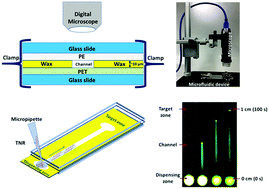当前位置:
X-MOL 学术
›
J. Mater. Chem. B
›
论文详情
Our official English website, www.x-mol.net, welcomes your
feedback! (Note: you will need to create a separate account there.)
Characterization and application of fluidic properties of trinucleotide repeat sequences by wax-on-plastic microfluidics.
Journal of Materials Chemistry B ( IF 6.1 ) Pub Date : 2020-01-02 , DOI: 10.1039/c9tb02208b Ahmad Zaman Qamar 1 , Narges Asefifeyzabadi 1 , Motahareh Taki 1 , Swati Naphade 2 , Lisa M Ellerby 2 , Mohtashim Hassan Shamsi 1
Journal of Materials Chemistry B ( IF 6.1 ) Pub Date : 2020-01-02 , DOI: 10.1039/c9tb02208b Ahmad Zaman Qamar 1 , Narges Asefifeyzabadi 1 , Motahareh Taki 1 , Swati Naphade 2 , Lisa M Ellerby 2 , Mohtashim Hassan Shamsi 1
Affiliation

|
Trinucleotide repeat (TNR) sequences introduce sequence-directed flexibility in the genomic makeup of all living species leading to unique non-canonical structure formation. In humans, the expansions of TNR sequences are responsible for almost 24 neurodegenerative and neuromuscular diseases because their unique structures disrupt cell functions. The biophysical studies of these sequences affect their electrophoretic mobility and spectroscopic signatures. Here, we demonstrate a novel strategy to characterize and discriminate the TNR sequences by monitoring their capillary flow in the absence of an external driving force using wax-on-plastic microchannels. The wax-on-plastic microfluidic system translates the sequence-directed flexibility of TNR into differential flow dynamics. Several variables were used to characterize sequences including concentration, single- vs. double-stranded samples, type of repeat sequence, length of the repeat sequence, presence of mismatches in duplex, and presence of metal ion. All these variables were found to influence the flow velocities of TNR sequences as these factors directly affect the structural flexibility of TNR at the molecular level. An overall trend was observed as the higher flexibility in the TNR structure leads to lower capillary flow. After testing samples derived from relevant cells harboring expanded TNR sequences, it is concluded that this approach may transform into a reagent-free and pump-free biosensing platform to detect microsatellite expansion diseases.
中文翻译:

塑料蜡上微流控技术对三核苷酸重复序列的流体性质进行表征和应用。
三核苷酸重复(TNR)序列在所有生物物种的基因组组成中引入了序列定向的灵活性,从而导致了独特的非规范结构形成。在人类中,TNR序列的扩展可导致近24种神经退行性疾病和神经肌肉疾病,因为它们的独特结构会破坏细胞功能。这些序列的生物物理研究影响其电泳迁移率和光谱特征。在这里,我们展示了一种新颖的策略来表征和区分TNR序列,方法是在无外部驱动力的情况下使用蜡上塑料微通道监测TNR序列的毛细流。塑料上蜡微流体系统将TNR的顺序控制灵活性转化为差分流动动力学。使用了几个变量来表征序列,包括浓度,单链与双链样品,重复序列的类型,重复序列的长度,双链体中错配的存在以及金属离子的存在。发现所有这些变量都影响TNR序列的流速,因为这些因素在分子水平上直接影响TNR的结构柔性。观察到总体趋势,因为TNR结构中较高的柔韧性导致较低的毛细管流动。在测试了具有扩展的TNR序列的相关细胞的样本后,得出的结论是,该方法可以转变为无试剂和无泵的生物传感平台,以检测微卫星扩展疾病。双工中存在错配,并且存在金属离子。发现所有这些变量都影响TNR序列的流速,因为这些因素在分子水平上直接影响TNR的结构柔性。观察到总体趋势,因为TNR结构中较高的柔韧性导致较低的毛细管流动。在测试了具有扩展的TNR序列的相关细胞的样本后,得出的结论是,该方法可以转变为无试剂和无泵的生物传感平台,以检测微卫星扩展疾病。双工中存在错配,并且存在金属离子。发现所有这些变量都影响TNR序列的流速,因为这些因素在分子水平上直接影响TNR的结构柔性。观察到总体趋势,因为TNR结构中较高的柔韧性导致较低的毛细管流动。在测试了具有扩展的TNR序列的相关细胞的样本后,得出的结论是,该方法可以转变为无试剂和无泵的生物传感平台,以检测微卫星扩展疾病。观察到总体趋势,因为TNR结构中较高的柔韧性导致较低的毛细管流动。在测试了具有扩展的TNR序列的相关细胞的样本后,得出的结论是,该方法可以转变为无试剂和无泵的生物传感平台,以检测微卫星扩展疾病。观察到总体趋势,因为TNR结构中较高的柔韧性导致较低的毛细管流动。在测试了具有扩展的TNR序列的相关细胞的样本后,得出的结论是,该方法可以转变为无试剂和无泵的生物传感平台,以检测微卫星扩展疾病。
更新日期:2020-02-10
中文翻译:

塑料蜡上微流控技术对三核苷酸重复序列的流体性质进行表征和应用。
三核苷酸重复(TNR)序列在所有生物物种的基因组组成中引入了序列定向的灵活性,从而导致了独特的非规范结构形成。在人类中,TNR序列的扩展可导致近24种神经退行性疾病和神经肌肉疾病,因为它们的独特结构会破坏细胞功能。这些序列的生物物理研究影响其电泳迁移率和光谱特征。在这里,我们展示了一种新颖的策略来表征和区分TNR序列,方法是在无外部驱动力的情况下使用蜡上塑料微通道监测TNR序列的毛细流。塑料上蜡微流体系统将TNR的顺序控制灵活性转化为差分流动动力学。使用了几个变量来表征序列,包括浓度,单链与双链样品,重复序列的类型,重复序列的长度,双链体中错配的存在以及金属离子的存在。发现所有这些变量都影响TNR序列的流速,因为这些因素在分子水平上直接影响TNR的结构柔性。观察到总体趋势,因为TNR结构中较高的柔韧性导致较低的毛细管流动。在测试了具有扩展的TNR序列的相关细胞的样本后,得出的结论是,该方法可以转变为无试剂和无泵的生物传感平台,以检测微卫星扩展疾病。双工中存在错配,并且存在金属离子。发现所有这些变量都影响TNR序列的流速,因为这些因素在分子水平上直接影响TNR的结构柔性。观察到总体趋势,因为TNR结构中较高的柔韧性导致较低的毛细管流动。在测试了具有扩展的TNR序列的相关细胞的样本后,得出的结论是,该方法可以转变为无试剂和无泵的生物传感平台,以检测微卫星扩展疾病。双工中存在错配,并且存在金属离子。发现所有这些变量都影响TNR序列的流速,因为这些因素在分子水平上直接影响TNR的结构柔性。观察到总体趋势,因为TNR结构中较高的柔韧性导致较低的毛细管流动。在测试了具有扩展的TNR序列的相关细胞的样本后,得出的结论是,该方法可以转变为无试剂和无泵的生物传感平台,以检测微卫星扩展疾病。观察到总体趋势,因为TNR结构中较高的柔韧性导致较低的毛细管流动。在测试了具有扩展的TNR序列的相关细胞的样本后,得出的结论是,该方法可以转变为无试剂和无泵的生物传感平台,以检测微卫星扩展疾病。观察到总体趋势,因为TNR结构中较高的柔韧性导致较低的毛细管流动。在测试了具有扩展的TNR序列的相关细胞的样本后,得出的结论是,该方法可以转变为无试剂和无泵的生物传感平台,以检测微卫星扩展疾病。











































 京公网安备 11010802027423号
京公网安备 11010802027423号